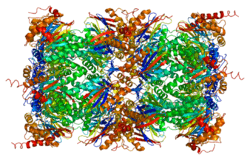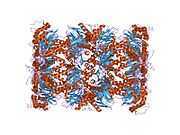PSMB3
Proteasome subunit beta type-3 is also know as 20S proteasome subunit beta-3 a protein that in humans is encoded by the PSMB3 gene.[1] This protein is one of the 17 essential subunits (alpha subunits 1-7, constitutive beta subunits 1-7, and inducible subunits including beta1i, beta2i, beta5i) that contributes to the complete assembly of 20S proteasome complex. In particular, proteasome subunit beta type-2, along with other beta subunits, assemble into two heptameric rings and subsequently a proteolytic chamber for substrate degradation.The eukaryotic proteasome recognized degradable proteins, including damaged proteins for protein quality control purpose or key regulatory protein components for dynamic biological precesses. An essential function of a modified proteasome, the immunoproteasome, is the processing of class I MHC peptides.
Structure
Protein Expression
The gene PSMB3 encodes a member of the proteasome B-type family, also known as the T1B family, that is a 20S core beta subunit. Pseudogenes have been identified on chromosomes 2 and 12.[2] The gene has 6 exons and locates at chromosome band 17q12. The human protein proteasome subunit beta type-3 is 23 kDa in size and composed of 205 amino acids. The calculated theoretical pI of this protein is 6.14.
Complex assembly
The proteasome is a multicatalytic proteinase complex with a highly ordered 20S core structure. This barrel-shaped core structure is composed of 4 axially stacked rings of 28 non-identical subunits: the two end rings are each formed by 7 alpha subunits, and the two central rings are each formed by 7 beta subunits. Three beta subunits (beta1, beta2, and beta5) each contains a proteolytic active site and has distinct substrate preferences. Proteasomes are distributed throughout eukaryotic cells at a high concentration and cleave peptides in an ATP/ubiquitin-dependent process in a non-lysosomal pathway.[3][4]
Function
Protein functions are supported by its tertiary structure and its interaction with associating partners. As one of 28 subunits of 20S proteasome, protein proteasome subunit beta type-3 contributes to form a proteolytic environment for substrate degradation. Evidences of the crystal structures of isolated 20S proteasome complex demonstrate that the two rings of beta subunits form a proteolytic chamber and maintain all their active sites of proteolysis within the chamber.[4] Concomitantly, the rings of alpha subunits form the entrance for substrates entering the proteolytic chamber. In an inactivated 20S proteasome complex, the gate into the internal proteolytic chamber are guarded by the N-terminal tails of specific alpha-subunit. This unique structure design prevents random encounter between proteolytic active sites and protein substrate, which makes protein degradation a well-regulated process.[5][6] 20S proteasome complex, by itself, is usually functionally inactive. The proteolytic capacity of 20S core particle (CP) can be activated when CP associates with one or two regulatory particles (RP) on one or both side of alpha rings. These regulatory particles include 19S proteasome complexes, 11S proteasome complex, etc. Following the CP-RP association, the confirmation of certain alpha subunits will change and consequently cause the opening of substrate entrance gate. Besides RPs, the 20S proteasomes can also be effectively activated by other mild chemical treatments, such as exposure to low levels of sodium dodecylsulfate (SDS) or NP-14.[6][7]
Clinical significance
The proteasomes are an pivotal component for the Ubiquitin-Proteasome System (UPS) [8] and corresponding cellular Protein Quality Control (PQC). Compromised proteasome complex assembly leads to reduced proteolytic activities and accumulation of damaged or misfolded protein species. Such protein accumulation has become phenotypic characteristics of neurodegenerative diseases,[9][10] cardiovascular diseases,[11][12][13] and systemic DNA damage responses.[14]
Interactions
PSMB3 has been shown to interact with PLK1.[15]
References
- ↑ Nothwang HG, Tamura T, Tanaka K, Ichihara A (Nov 1994). "Sequence analyses and inter-species comparisons of three novel human proteasomal subunits, HsN3, HsC7-I and HsC10-II, confine potential proteolytic active-site residues". Biochim Biophys Acta 1219 (2): 361–8. doi:10.1016/0167-4781(94)90060-4. PMID 7918633.
- ↑ "Entrez Gene: PSMB3 proteasome (prosome, macropain) subunit, beta type, 3".
- ↑ Coux O, Tanaka K, Goldberg AL (1996). "Structure and functions of the 20S and 26S proteasomes". Annual Review of Biochemistry 65: 801–47. doi:10.1146/annurev.bi.65.070196.004101. PMID 8811196.
- ↑ 4.0 4.1 Tomko RJ, Hochstrasser M (2013). "Molecular architecture and assembly of the eukaryotic proteasome". Annual Review of Biochemistry 82: 415–45. doi:10.1146/annurev-biochem-060410-150257. PMID 23495936.
- ↑ Groll M, Ditzel L, Löwe J, Stock D, Bochtler M, Bartunik HD et al. (Apr 1997). "Structure of 20S proteasome from yeast at 2.4 A resolution". Nature 386 (6624): 463–71. doi:10.1038/386463a0. PMID 9087403.
- ↑ 6.0 6.1 Groll M, Bajorek M, Köhler A, Moroder L, Rubin DM, Huber R et al. (Nov 2000). "A gated channel into the proteasome core particle". Nature Structural Biology 7 (11): 1062–7. doi:10.1038/80992. PMID 11062564.
- ↑ Zong C, Gomes AV, Drews O, Li X, Young GW, Berhane B et al. (Aug 2006). "Regulation of murine cardiac 20S proteasomes: role of associating partners". Circulation Research 99 (4): 372–80. doi:10.1161/01.RES.0000237389.40000.02. PMID 16857963.
- ↑ Kleiger G, Mayor T (Jun 2014). "Perilous journey: a tour of the ubiquitin-proteasome system". Trends in Cell Biology 24 (6): 352–9. doi:10.1016/j.tcb.2013.12.003. PMID 24457024.
- ↑ Sulistio YA, Heese K (Jan 2015). "The Ubiquitin-Proteasome System and Molecular Chaperone Deregulation in Alzheimer's Disease". Molecular Neurobiology. doi:10.1007/s12035-014-9063-4. PMID 25561438.
- ↑ Ortega Z, Lucas JJ (2014). "Ubiquitin-proteasome system involvement in Huntington's disease". Frontiers in Molecular Neuroscience 7: 77. doi:10.3389/fnmol.2014.00077. PMID 25324717.
- ↑ Sandri M, Robbins J (Jun 2014). "Proteotoxicity: an underappreciated pathology in cardiac disease". Journal of Molecular and Cellular Cardiology 71: 3–10. doi:10.1016/j.yjmcc.2013.12.015. PMID 24380730.
- ↑ Drews O, Taegtmeyer H (Dec 2014). "Targeting the ubiquitin-proteasome system in heart disease: the basis for new therapeutic strategies". Antioxidants & Redox Signaling 21 (17): 2322–43. doi:10.1089/ars.2013.5823. PMID 25133688.
- ↑ Wang ZV, Hill JA (Feb 2015). "Protein quality control and metabolism: bidirectional control in the heart". Cell Metabolism 21 (2): 215–26. doi:10.1016/j.cmet.2015.01.016. PMID 25651176.
- ↑ Ermolaeva MA, Dakhovnik A, Schumacher B (Jan 2015). "Quality control mechanisms in cellular and systemic DNA damage responses". Ageing Research Reviews. doi:10.1016/j.arr.2014.12.009. PMID 25560147.
- ↑ Feng Y, Longo DL, Ferris DK (Jan 2001). "Polo-like kinase interacts with proteasomes and regulates their activity". Cell Growth Differ. 12 (1): 29–37. PMID 11205743.
Further reading
- Coux O, Tanaka K, Goldberg AL (1996). "Structure and functions of the 20S and 26S proteasomes.". Annu. Rev. Biochem. 65: 801–47. doi:10.1146/annurev.bi.65.070196.004101. PMID 8811196.
- Goff SP (2003). "Death by deamination: a novel host restriction system for HIV-1.". Cell 114 (3): 281–3. doi:10.1016/S0092-8674(03)00602-0. PMID 12914693.
- Rasmussen HH, van Damme J, Puype M, Gesser B, Celis JE, Vandekerckhove J (1993). "Microsequences of 145 proteins recorded in the two-dimensional gel protein database of normal human epidermal keratinocytes.". Electrophoresis 13 (12): 960–9. doi:10.1002/elps.11501301199. PMID 1286667.
- Kristensen P, Johnsen AH, Uerkvitz W, Tanaka K, Hendil KB (1995). "Human proteasome subunits from 2-dimensional gels identified by partial sequencing.". Biochem. Biophys. Res. Commun. 205 (3): 1785–9. doi:10.1006/bbrc.1994.2876. PMID 7811265.
- Seeger M, Ferrell K, Frank R, Dubiel W (1997). "HIV-1 tat inhibits the 20 S proteasome and its 11 S regulator-mediated activation.". J. Biol. Chem. 272 (13): 8145–8. doi:10.1074/jbc.272.13.8145. PMID 9079628.
- McCusker D, Jones T, Sheer D, Trowsdale J (1998). "Genetic relationships of the genes encoding the human proteasome beta subunits and the proteasome PA28 complex.". Genomics 45 (2): 362–7. doi:10.1006/geno.1997.4948. PMID 9344661.
- Madani N, Kabat D (1998). "An endogenous inhibitor of human immunodeficiency virus in human lymphocytes is overcome by the viral Vif protein.". J. Virol. 72 (12): 10251–5. PMC 110608. PMID 9811770.
- Simon JH, Gaddis NC, Fouchier RA, Malim MH (1998). "Evidence for a newly discovered cellular anti-HIV-1 phenotype.". Nat. Med. 4 (12): 1397–400. doi:10.1038/3987. PMID 9846577.
- Elenich LA, Nandi D, Kent AE, McCluskey TS, Cruz M, Iyer MN et al. (1999). "The complete primary structure of mouse 20S proteasomes.". Immunogenetics 49 (10): 835–42. doi:10.1007/s002510050562. PMID 10436176.
- Mulder LC, Muesing MA (2000). "Degradation of HIV-1 integrase by the N-end rule pathway.". J. Biol. Chem. 275 (38): 29749–53. doi:10.1074/jbc.M004670200. PMID 10893419.
- Feng Y, Longo DL, Ferris DK (2001). "Polo-like kinase interacts with proteasomes and regulates their activity.". Cell Growth Differ. 12 (1): 29–37. PMID 11205743.
- Sheehy AM, Gaddis NC, Choi JD, Malim MH (2002). "Isolation of a human gene that inhibits HIV-1 infection and is suppressed by the viral Vif protein.". Nature 418 (6898): 646–50. doi:10.1038/nature00939. PMID 12167863.
- Huang X, Seifert U, Salzmann U, Henklein P, Preissner R, Henke W et al. (2002). "The RTP site shared by the HIV-1 Tat protein and the 11S regulator subunit alpha is crucial for their effects on proteasome function including antigen processing.". J. Mol. Biol. 323 (4): 771–82. doi:10.1016/S0022-2836(02)00998-1. PMID 12419264.
- Gaddis NC, Chertova E, Sheehy AM, Henderson LE, Malim MH (2003). "Comprehensive investigation of the molecular defect in vif-deficient human immunodeficiency virus type 1 virions.". J. Virol. 77 (10): 5810–20. doi:10.1128/JVI.77.10.5810-5820.2003. PMC 154025. PMID 12719574.
- Lecossier D, Bouchonnet F, Clavel F, Hance AJ (2003). "Hypermutation of HIV-1 DNA in the absence of the Vif protein.". Science 300 (5622): 1112. doi:10.1126/science.1083338. PMID 12750511.
- Zhang H, Yang B, Pomerantz RJ, Zhang C, Arunachalam SC, Gao L (2003). "The cytidine deaminase CEM15 induces hypermutation in newly synthesized HIV-1 DNA.". Nature 424 (6944): 94–8. doi:10.1038/nature01707. PMC 1350966. PMID 12808465.
- Mangeat B, Turelli P, Caron G, Friedli M, Perrin L, Trono D (2003). "Broad antiretroviral defence by human APOBEC3G through lethal editing of nascent reverse transcripts.". Nature 424 (6944): 99–103. doi:10.1038/nature01709. PMID 12808466.
| |||||||||


